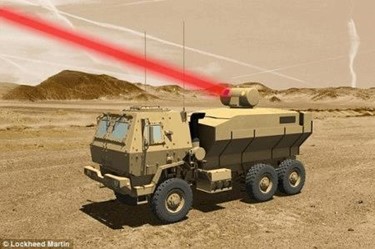Lockheed Martin Readies 60 kW Fiber Laser Weapon For U.S. Army
By Jof Enriquez,
Follow me on Twitter @jofenriq

Lockheed Martin says it is set to deliver a 60 kW fiber optic laser weapon to the U.S. Army, which intends to mount it atop tactical ground vehicles to neutralize enemy drones, rockets, and mortars.
The Beam Combined Fiber Laser brings together multiple individual lasers generated through fiber optics into a single, powerful beam. Lockheed Martin had demonstrated a single beam of 58 kW — a world record for this laser type — during its most recent test. The company says the laser could achieve 60 kW when it delivers the system for further testing at the U.S. Army Space and Missile Defense Command/Army Forces Strategic Command (SMDC/ARSTRAT) in Huntsville, Ala.
"Delivery of this laser represents an important milestone along the path to fielding a practical laser weapon system," said Paula Hartley, VP, Owego, New York general manager and Advanced Product Solutions within Lockheed Martin's Cyber, Ships & Advanced Technologies line of business, in a news release. "This milestone could not have been achieved without close partnership between the U.S. Army and Lockheed Martin; we are pleased to be able to deliver this system for their further integration and evaluation."
Mary J. Miller, deputy assistant secretary of the Army for Research and Technology, told the U.S. House Armed Services Committee's Subcommittee on Emerging Threats and Capabilities, "We have to make sure the lasers work and do the full set of scopes against the threats we project. And those threats include the counter-rockets, counter-artillery and counter-mortar as well as [Unmanned Aerial Vehicle] and cruise missile threats," reported the Daily Mail.
The U.S. Army is reportedly planning to deploy its advanced laser weapon in 2023.
Lockheed Martin began production of this modular-type laser at its Bothell, Wash. facility in October 2015. The laser is based on a design developed under the Department of Defense's (DoD) Robust Electric Laser Initiative (RELI) program, and has been further developed through investments by Lockheed Martin and the U.S. Army. The modular design makes it more affordable to produce and less prone to system failure, because chances for a single-point disruption are dramatically lessened. The Army previously tested a lower-powered 30 kW fiber laser called Athena, which successfully disabled the engine of a small truck during a field test in 2015.
"The inherent scalability of this beam combined laser system has allowed us to build the first 60kW-class fiber laser for the U.S. Army," said Robert Afzal, Ph.D., senior fellow for Laser and Sensor Systems. "We have shown that a powerful directed energy laser is now sufficiently light-weight, low volume and reliable enough to be deployed on tactical vehicles for defensive applications on land, at sea and in the air."
Azfal said that the Beam Combined Fiber Laser is near "diffraction-limited," meaning it is close to the physical limits for focusing energy toward a single, small spot. The laser also is highly efficient, capable of translating over 43 percent of the electricity that powered it directly into the single laser beam it emits.
The U.S. Army also has the High Energy Laser Mobile Demonstrator (HEL-MD), the first mobile, high-energy laser, counter rocket, artillery and mortar (C-RAM) platform installed on military vehicles.
Meanwhile, the U.S. Navy has the Laser Weapon System (LaWS), which is deployed on the USS Ponce to destroy unmanned aerial vehicles (UAVs), and has commissioned Northrop Grumman to develop a Laser Weapon System Demonstrator (LWSD). The Marine Corps operates Ground Based Air Defense System (GBAD), a 25 kW Humvee-mounted short-range laser weapon system for targeting enemy drones.
The DoD has increased the funding for fiscal year 2017 for research and development of directed-energy technologies, including high-energy lasers and RF-based weapons.
